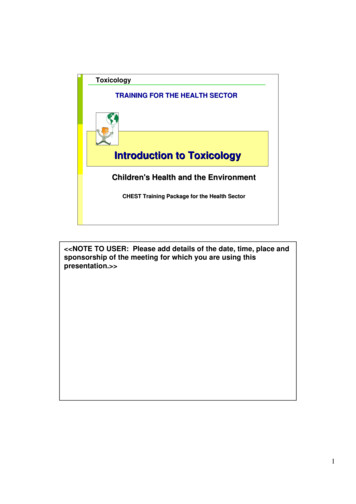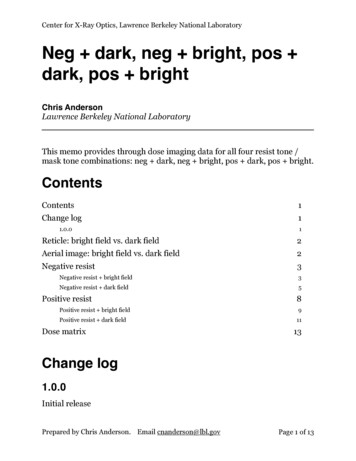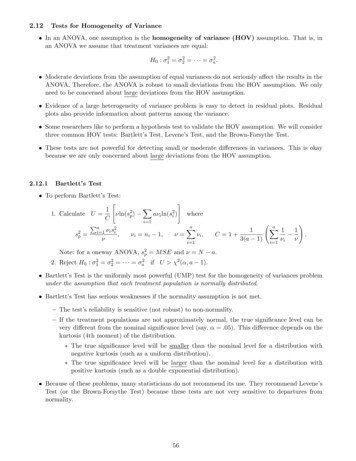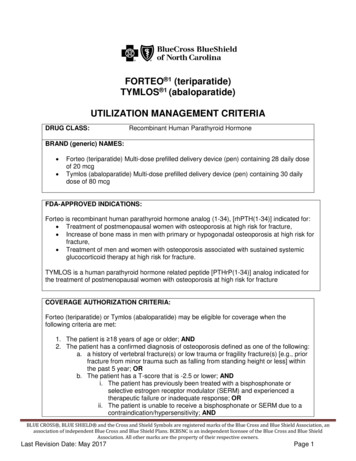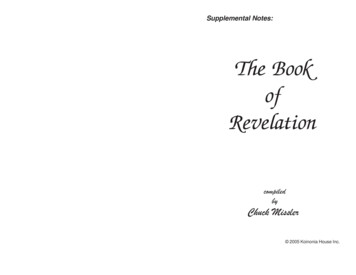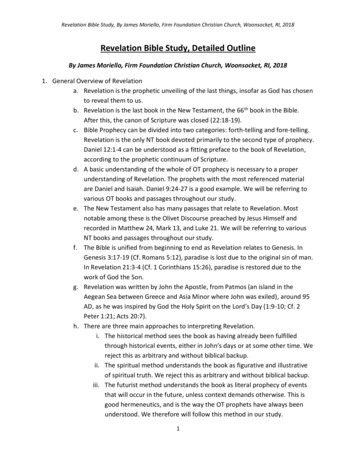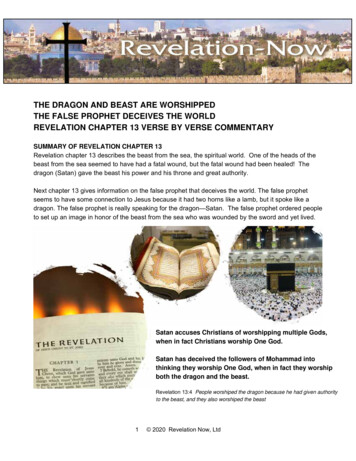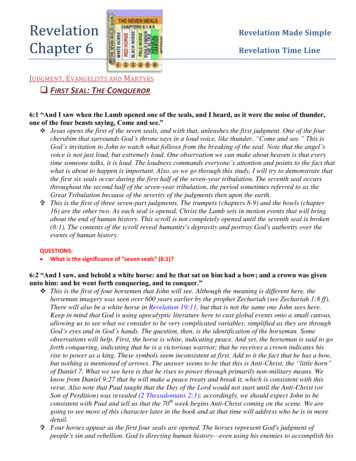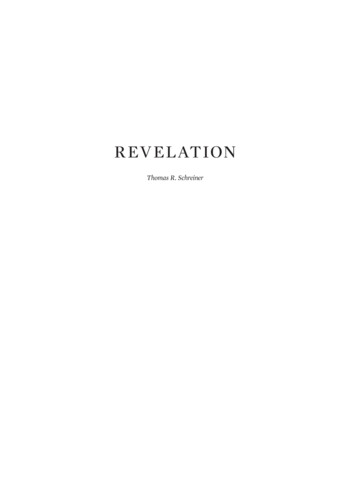
Transcription
R EV EL ATIONThomas R. SchreinerExpository Commentary - Volume 12.int.indd 5255/15/18 1:30 PM
Expository Commentary - Volume 12.int.indd 5265/15/18 1:30 PM
INTRODUCTION TOR EVEL AT IONOverviewG. K. Chesterton humorously quipped regarding Revelation, “Though St. John theEvangelist saw many strange monsters in his vision, he saw no creature so wild asone of his own commentators.”1 We are reminded at the outset that the book ofRevelation has brilliance and beauty outshining any attempt to explain it.2 Johnwrote Revelation to churches facing persecution and being tempted to compromisewith Roman imperial power and cave in to the social pressures of pagan society. Hecalls upon these churches to stay faithful until the end, reminding them that Godand Christ are sovereign over the evil they face. Believers should rejoice, despitepersecution and discrimination from opponents, for they can be assured a placein the heavenly city since they are washed clean by the blood of the Lamb. If theyendure until the end, they will enjoy God and the Lamb forever. Ultimately, Godwill vindicate those who are his. Furthermore, God reigns over history, and hisreign is expressed in his judgments unleashed on the earth. Those judgments willculminate in the final judgment, where the wicked will be cast into the lake of fireand the righteous will enter the new Jerusalem. God’s name will be honored andpraised forever for vindicating the righteous and punishing the wicked.TitleThe title of the book comes from the first word in the Greek text: Revelation(Apokalypsis). The book is a revelation of Jesus Christ and from Jesus Christ (cf.comment on Rev. 1:1). Jesus Christ is the subject matter of the book; the book isthoroughly and strikingly Christological. At the same time, Jesus transmitted whatwas given to him to an angel, the angel passed it on to John, and John passed iton to the churches.1 Gilbert K. Chesterton, Orthodoxy (New York: John Lane, 1909), 29.2 This commentary is written at a semipopular level and hence doesn’t interact with other scholars who havewritten on Revelation. I was originally taught Revelation from a dispensational standpoint. I learned muchfrom that viewpoint (even if I finally disagree rather significantly), and one can find that perspective in thecommentaries of John Walvoord, Robert Thomas, and Paige Patterson. I also stand in debt to a number of othercommentators. See especially the commentaries by Leon Morris, Dennis Johnson, G. B. Caird, Bruce Metzger,Robert Mounce, George Eldon Ladd, Vern Poythress, James M. Hamilton Jr., David Aune, Greg Beale, GrantOsborne, and George Beasley-Murray. Two books on the theology of Revelation by Richard Bauckham alsoinfluenced me. See his The Theology of the Book of Revelation (Cambridge: Cambridge University Press, 1993),and The Climax of Prophecy: Studies on the Book of Revelation (London: T&T Clark, 1993).Expository Commentary - Volume 12.int.indd 5275/15/18 1:30 PM
R e v e lat i o n, INTRO528AuthorThe author identifies himself as John (1:1, 4, 9; 22:8) but doesn’t identify himselfas an apostle. He informs us he wrote the letter from Patmos, an island in theAegean Sea opposite Miletus off the coast of modern-day Turkey. Various theorieshave been offered about authorship, but the most probable is that the book waswritten by either the apostle John or a certain “John the Elder.” Identifying theauthor as the apostle John is the most convincing, for several reasons. First, anauthor who didn’t mention his authority was probably a person of prestige andthus felt no need to refer to his office. The apostle John fits this description best.Second, the earliest and most common view among the church fathers (including Justin Martyr, Irenaeus, Tertullian, and Clement of Alexandria) was that theapostle John wrote the book. Third, Eusebius of Caesarea identified the author asJohn the Elder based on Papias’s testimony (Ecclesiastical History 3.39.2–4), and thisview has been endorsed by some prominent scholars today. Eusebius, however,probably misinterpreted Papias’s words, for Papias wasn’t speaking of two Johns.If we read Papias carefully, we see that John the Elder and John the Apostle werethe same person, for Papias calls the apostles “elders.” Furthermore, Eusebius hadpersonal reasons for wanting to distance the apostle John from Revelation, for hewas biased against the book.The most significant objection to apostolic authorship is the style of Revelation,which departs significantly from the style of the Gospel of John.3 The objectionisn’t compelling, for the different style is explained by the apocalyptic genre ofthe work. Remarkable differences between the Gospel of John and the book ofRevelation are surely present, but the simple Greek style of Revelation fits withwhat we find in the Gospel of John.4 Others have objected that the theology ofRevelation contradicts John’s Gospel, for the former declares judgment on God’senemies while the latter proclaims God’s love. The dichotomy erected is a falseone, for judgment is threatened in the Gospel as well (John 3:36; 5:22, 29; 12:48),and Revelation promises salvation to those who repent and wash their robes inthe blood of the Lamb (Rev. 3:19–21; 7:13–14; 9:20–21; 22:14). We also see somerather striking and unusual points of contact: Jesus in both books is the Word ofGod (John 1:1, 14; Rev. 19:13), the Lamb of God (John 1:29, 36; Rev. 5:6; 19:7, 9;21:9), and the Son of Man (John 1:51; 3:13, 14; Rev. 1:12–16). The simplest andmost persuasive solution is that John the Apostle wrote the book of Revelation.Date and OccasionScholars dispute whether Revelation was written in the 60s AD, when Neroreigned as emperor (AD 54–68), or in the 90s, when Domitian reigned (AD 81–96).Certainty is impossible, but a date in the 90s seems preferable for at least three3 On the syntax and vocabulary of the book, see David E. Aune, Revelation 1–5, WBC (Dallas: Word, 1997),clx–ccxi. I believe the apostle John also wrote the Gospel of John, but the scope of this present work prohibitsa full defense of that view.4 Often I designate the book of Revelation simply as “Revelation.” Context will make it clear when the bookof Revelation is intended.Expository Commentary - Volume 12.int.indd 5285/15/18 1:30 PM
529 R e v e lat i o n, INTROreasons. First, Irenaeus is most plausibly interpreted as saying Revelation waswritten under Domitian, for he says, around the year AD 180, that the Apocalypsewas seen near the end of Domitian’s reign (Eusebius, Ecclesiastical History 3.18.3;Irenaeus, Against Heresies 5.30.3). Irenaeus’s close proximity to John gives his testimony credibility, for Irenaeus was a hearer of Polycarp (c. AD 70–160), and Polycarpwas, according to tradition, discipled by John the Apostle. Second, though the matter is disputed, it is likely that pressure to worship the emperor increased underDomitian, and the contents of Revelation fit with such a reality. The scattered andsporadic persecution in Revelation accords with the evidence of Domitian’s reign.The persecution wasn’t state sponsored or official, but it was always threatenedand sometimes broke out with ferocity, as table 9.1 shows.TABLE 9.1: Indications of Persecution in Revelation1:9John banished to Patmos2:13Antipas put to death3:10Trial on whole earth6:9–11Martyrs under the altar16:6Bab ylon poured out blood of God’s people17:6Bab ylon drunk from blood of saints18:24Bab ylon drunk from blood of saints19:2God avenged blood of his servants20:4Martyrs beheadedThird, Laodicea is described as a rich city (Rev. 3:14–21), but it suffered from anearthquake in AD 60–61, and a date in the 60s would have been too early for thecity to have recovered its riches.Revelation, then, was probably written in the 90s, to churches facing sporadicpersecution from Rome, with a particular threat from the imperial cult. It is probable that Jews in their communities also discriminated against Christians andperhaps even reported them to the authorities (2:9; 3:9). Christians also faced localsocial pressures from trade guilds, which celebrated festivals for various gods andengaged in cultic practices; the failure of Christians to participate in such activitieswould have suggested that they were not good citizens. John wrote Revelationto encourage believers to endure until the final day, promising them they wouldenter the new Jerusalem if they continued to persevere in faith.Genre and Literary StructureThe book of Revelation has a mixed genre, including epistolary and propheticelements, though the apocalyptic character of the book especially stands out. Thebook is specifically identified by the author as a prophecy (1:3; 22:7, 9, 10, 18, 19;cf. 10:8–11), and it includes seven letters to churches (2:1–3:22). The epistolaryExpository Commentary - Volume 12.int.indd 5295/15/18 1:30 PM
R e v e lat i o n, INTRO530character of the book indicates it was to be read orally in the churches in its entirety(1:3). Still, what characterizes the book most notably is its apocalyptic genre. Butit is apocalypse merged with prophecy, so that the book is prophetic/apocalyptic,written to call the church to faith and action in perilous times. The apocalypticgenre wasn’t an innovation of John, for parts of Isaiah (24:1–27:13), Ezekiel (37:1–39:29), Daniel (7:1–12:14), and Zechariah (esp. 9:1–14:21) are apocalyptic. Jewishbooks written during the Second Temple period were also apocalyptic, including1–2 Enoch, 2–3 Baruch, 4 Ezra, and the Apocalypse of Abraham. The apocalypse seminarof the Society of Biblical Literature studied the apocalyptic genre for a numberof years and produced the following definition. Every word of the definition wasdoubtless debated and discussed carefully, since it is the product of a committee ofexperts on apocalyptic literature. This doesn’t mean the definition is flawless, yetwe should pay close attention to a definition composed by experts in apocalypticliterature. They write,Apocalypse is a genre of revelatory literature with a narrative framework,in which a revelation is mediated by an otherworldly being to a humanrecipient, disclosing a transcendent reality which is both temporal, insofaras it envisages eschatological salvation, and spatial, insofar as it involvesanother supernatural world. Apocalypse was intended to interpret presentearthly circumstances in light of the supernatural world and of the future,and to influence both the understanding and the behavior of the audienceby means of divine authority.5A more popular and less technical way of putting it is as follows: Apocalypseis a supernatural unveiling of what is about to take place. A divine disclosure isgiven, usually by angels to some prominent person, in which God promises tointervene in human history, destroy evil, and bring his kingdom. We should addthat apocalypses are given to encourage and strengthen those who are sufferingto persevere and continue in the faith. Readers are encouraged to “hang on,” forthey will triumph ultimately.Certain features characterize apocalyptic literature, the most important beingits symbolic language. Some interpreters approach the book with what I call“newspaper eschatology,” interpreting Revelation through contemporary events.Such an approach, however, is arbitrary and inconsistent. It is arbitrary inasmuchas the interpretation changes as history marches on, as anyone knows who hasfollowed this approach over the years. It is inconsistent inasmuch as the claim totake the book “literally” is contradicted by their own symbolic interpretations. Noone actually follows a literalistic hermeneutic in reading the book. For instance,no one believes Jesus really has a double-edged sword in his mouth (Rev. 1:16).The symbolism of the book should produce humility in us as interpreters, for wemust confess we don’t always know how to interpret the symbols. In any case, the5 See John J. Collins, “Introduction: Towards the Morphology of a Genre,” in Apocalypse: The Morphology of aGenre, Semeia 14 (Chico, CA: Scholars, 1979), 9.Expository Commentary - Volume 12.int.indd 5305/15/18 1:30 PM
531 R e v e lat i o n, INTROmost important background for interpreting the book is not the newspaper butthe OT, for Revelation is infused with OT allusions. Virtually every line of the bookechoes the OT witness. Hence, the fundamental reason some interpreters go astrayis that they don’t anchor their reading of Revelation in the OT.The symbolic nature of Revelation should be especially observed relative tonumbers. Revelation uses the numbers four, seven, ten, twelve, and multiplesof the same symbolically. Some dispensational interpreters have argued thebook should be interpreted literally if possible, but such a stance is flawed, forsaying we must interpret literally begs the question. We must recognize insteadthat authors may intend symbolism in their writings. The art of interpretingRevelation can’t be solved with a prefabricated rule about literal interpretation. Instead, we should interpret Revelation in accord with the genre used; ifthe language used is symbolic, we must interpret it in light of such symbolicconventions.Other features of apocalypse include visions, angels, and otherworldly creatures. Often apocalypses are pseudonymous, but Revelation clearly stands apart,for the author identifies himself as John and doesn’t appeal to some famous person from the past. The following list summarizes some features of apocalypticliterature:Historical dualismVisionsPsuedonymity (Revelation edicted woesIt is helpful in interpreting Revelation to distinguish four levels of communication.6 First is the linguistic level: the text itself, the words John wrote. Secondare the visions John saw, recorded in the text. Third is the referential level, thehistorical referent of the visions. Fourth is the symbolic level, explicating viaimages the larger significance of the historical referent. One example should suffice. First, at the textual level John wrote about the beast (Rev. 13:1–8). Second,at the visionary level he presumably saw an actual beast that was quite horrible.Third, the referent to the beast is most likely the Roman emperor. Fourth, theRoman emperor may stand symbolically for any and all empires opposed tothe one true God. I am not claiming that all four elements are present in everyinstance in Revelation, nor is it always easy to apply these four principles to whatwe find in the book. Still, the four levels have a heuristic value in assisting us aswe attempt to interpret the book.6 For these distinctions, see Vern Sheridan Poythress, “Genre and Hermeneutics in Revelation 20:1–6,” JETS36 (1993): 41–54.Expository Commentary - Volume 12.int.indd 5315/15/18 1:30 PM
R e v e lat i o n, INTRO532Theology of RevelationTHE REALITY OF EVILThe message of Revelation won’t resonate with readers unless the evil opposingGod is recognized. The prime mover of evil in the world is the Devil, or Satan.The nature of the Devil is communicated through the names he is given. He isidentified as the “devil” (diabolos), meaning he accuses the people of God (2:10;12:9, 12; 20:2, 10). The Devil is also called the “serpent” (ophis), which reaches backto Genesis 3 and recognizes the Devil as the one who tempted Eve (Rev. 12:9, 14,15; 20:2)—which explains why he is called the “ancient serpent.” The Devil is alsocalled a “dragon” (drakōn), representing a mythological monster and formidableenemy who hates and oppresses the people of God (12:3, 4, 7, 9, 13, 16, 17; 13:2, 4;16:13; 20:2).7 Finally, the Devil is identified as “Satan” (satanas), the great adversaryof God, Christ, and his people (2:9, 13, 24; 3:9; 12:9; 20:2, 7). “Satan” transliterates the Hebrew term for accuser/adversary, translated into Greek as diabolos inZechariah 3:1–2. Hence it too may have the notion of accuser. Satan persecutes thepeople of God incessantly (Rev. 12:13–17). He even uses religion, if it accords withhis purposes, and thus even a Jewish synagogue, insofar as it oppresses the church,is satanic (2:9–10; 3:9). Satan calls forth the beast (the Roman Empire), grantingit authority to prosecute his war against the saints (13:1–18). Satan deceives theworld, hindering it from seeing the love of God in Jesus Christ (12:9; 20:8, 10).Satan doesn’t act alone. Indeed, the beast and the false prophet are part of the“unholy trinity” (16:13). One of the primary ways Satan works is counterfeitingand parodying the things of God. The dragon and the beast long above all else tobe worshiped and praised, arrogating to themselves the glory belonging to Godand the Lamb (13:4; 14:9, 11; 16:2; 20:4). In the case of the first beast, we have aparody of the resurrection, since it “dies” and returns to life (13:3), and hence thebeast seems to be invincible, even speaking against God with impunity (13:4–5).This first beast, which is the Roman Empire and represents all human governmentopposed to God, is summoned by Satan from the sea (12:17–13:2) and comes fromthe abyss (11:7). The beast persecutes, kills, and discriminates against the people ofGod (11:7; 13:7, 16–17), exercising political power in the world (13:7). The secondbeast, the false prophet (13:11–18; 19:20), tries to impersonate the Lamb (13:11)and the Holy Spirit. The second beast is a parody of the Spirit in that he bestowsglory on the first beast (13:14–15) and allegedly speaks divine words. The secondbeast stands for false religion, which, as Paul says, has the “appearance of godliness” but lacks its “power” (2 Tim. 3:5). The beast and the false prophet make waragainst God and Christ, resisting divine authority at every turn (Rev. 19:19–21).The evil permeating the world is also represented by Bab ylon (14:8; 16:19;17:1–19:5). Bab ylon is the city of Rome (17:18), but it also represents whatAugustine called the “city of man,” opposed to the “city of God.” Bab ylon is aharlot, a wicked and brazen witch. The people of the earth join her harlotry by7 I am not suggesting that Satan himself is mythical!Expository Commentary - Volume 12.int.indd 5325/15/18 1:30 PM
533 R e v e lat i o n, INTROforsaking the one true God (17:2). Her detestable idolatry manifests itself in herfierce opposition to the people of God, the spilling of the blood of God’s saints(17:6; 18:24; 19:2), and her lust for economic security. Bab ylon is drunk with theblood of those who belong to God. And it is not as if only a few participate in herprostitution—nations, merchants, and kings join to enjoy the riches of the godlesssystem (18:3). The city of man lives for luxury and comfort, but its day of comfortand joy will be short-lived (18:9–24).Evil rules over all who don’t belong to Jesus Christ. Instead of worshipingand praising God and the Lamb, they have yielded their devotion to the dragon,the beast, and Bab ylon (13:8, 12). They are often called “the earth dwellers” (hoikatoikountes epi tēs gēs; cf. 3:10; 6:10; 8:13; 11:10; 13:8, 12, 14; 17:2, 8), which functions as a technical term for unbelievers who live on the earth. These “earth dwellers” live for this world instead of the coming new creation, and their names arenot inscribed in the book of life (17:8). The earth dwellers are deceived by the falseprophet and so give themselves to the beast (13:14). They get in bed with Bab ylon(17:2) and hence put to death God’s people and rejoice when saints are slain (6:10;11:10). Hence they will be judged (8:13).THE SUFFERING OF THE SAINTSThe evil dominating the world leads to the suffering of the saints—the peopleof God. Texts mentioning such suffering are found in a table under Date andOccasion, above. It should be underscored that Revelation was written to sufferingchurches, to Christians who faced implacable opposition from the governmentand society. It wasn’t written to believers who merely had an academic interest inprophecy. Jesus Christ called them to be ready to die for his sake (2:10); amid greatsuffering they were summoned to bear witness to the good news of Jesus Christ(11:3–14). Christians were being slain because of their testimony about JesusChrist and faithfulness to the Word of God (20:4), and Revelation makes it plainthat believers will be put to death until Jesus returns. The unholy trinity hates thepeople of God and tries to destroy them through discrimination and persecution.The church in Revelation is described as a martyr church. It doesn’t follow thatevery believer will actually be slain by those who oppose God, but every genuinebeliever will be persecuted and hated by the world (cf. 2 Tim. 3:12).CALL TO PERSEVERANCELinked to the suffering of believers is the call to persevere until the end. In the faceof great evil they must not buckle under pressure to compromise with Rome. Afterrecounting the rise of the beast and his resistance to God, John declares, “Here is acall for the endurance and faith of the saints” (Rev. 13:10). John reminds his readersof the judgment to be meted out on those who worship the beast; they will experience God’s unending wrath and torment (14:9–11). The impending judgmentsummons believers to perseverance: “Here is a call for the endurance of the saints,those who keep the commandments of God and their faith in Jesus” (14:12). InExpository Commentary - Volume 12.int.indd 5335/15/18 1:30 PM
R e v e lat i o n, INTRO534every one of the letters to the seven churches, believers are called to “conquer,” orovercome (2:7, 11, 17, 25–26; 3:5, 12, 21). Overcoming isn’t optional for believers.John isn’t saying that those who overcome will get a special reward above andbeyond eternal life. Instead, only those who overcome will eat from the tree of life(2:7). Only those who overcome will conquer the second death—the lake of fire(2:11; 20:14). Only those who overcome will have their names inscribed in the bookof life and wear white garments (3:5). Overcomers will inherit the promises, butthose who don’t overcome will experience the second death (21:8). Hence, the callto overcome is a matter of utmost seriousness; life and death are at stake!Those who stay morally awake and alert until the end will receive the garments of salvation (16:15). Those who belong to the Lamb are “called and chosen and faithful” (17:14). Those whose names are written in the book of life arejudged according to works (20:11–15), works indicating that they belong to God.Revelation 12:17 describes believers as “those who keep the commandments ofGod and hold to the testimony of Jesus.”The call to persevere should not, however, be interpreted as works-righteousness. The water of life is given freely to those who thirst (21:6; 22:17). But thosewho drink freely at the fountain of grace demonstrate that they have slaked theirthirst by continuing to follow Christ to the end. As 12:11 says, “They have conquered him by the blood of the Lamb and by the word of their testimony, for theyloved not their lives even unto death.”THE SOVEREIGNTY OF GODIn a world where evil resists God and his Christ so that God’s people are harassed,reviled, imprisoned, and slain, the question of God’s sovereignty isn’t merely anacademic matter. God declares at the outset and conclusion of Revelation that herules over history, for he is the “Alpha and the Omega” and the “beginning andthe end” (1:8; 21:6). Nothing that happens to God’s people comes as a surprise, noris it outside his sovereign control. God reigns over all history as the one “who isand who was and who is to come” (1:4, 8). John clearly draws on Exodus 3:14 anddeclares that God rules over the present, past, and future.The sovereignty of God is expressed powerfully in chapter 4, which functionsas an introduction to the remainder of the book after the letters to the churchesin chapters 2–3. John allows us to peek into heaven itself, where God as the everholy one sits on his throne, ruling over all. The word “throne” plays a major role inRevelation, forty times referring to God’s or Christ’s throne. John wants his readersto know that God reigns and rules in heaven, for he is the creator of all (4:11), andthe Creator is clearly sovereign. Here John reflects the theology of the OT, whereGod’s sovereignty as Creator is part of the warp and woof of its testimony.Revelation’s portrayal of God’s sovereignty is no mere abstraction. What isstriking and astonishing is God’s rule over the evil inflicted by the beast and thefalse prophet. John repeatedly tells readers the authority wielded by the beastand the false prophet “was given” (edothē) them by God (13:5, 7, 14, 15), includingExpository Commentary - Volume 12.int.indd 5345/15/18 1:30 PM
535 R e v e lat i o n, INTROactivities like blaspheming God and murdering believers. God’s goodness andholiness are not besmirched, as if he were evil (4:8), even though he rules over theevil unleashed in the world. The passive verb indicates God permitted evil to bedone. It must be noted that God didn’t do these evil deeds; they were the actionsof the beast and false prophet. Yet they would have no authority to do such evilunless granted it from above (cf. John 19:11). Nevertheless, evil finally implodesand destroys itself from within. The beast and ten kings will finally turn againstthe harlot, Bab ylon, and utterly destroy her (Rev. 17:16). The hatred and destruction inflicted on Bab ylon stem from the beast and his cronies, yet God fulfills hispurposes in these events (17:17). He even “put it into their hearts to carry out hispurpose” (17:17).God’s sovereignty reminds believers they can take comfort in their sufferings.Even if they don’t understand fully why they are suffering, they are assured thatGod is working out his purposes and plans in the evil intrigues of those opposedto him. Even though the evil they face is painful and agonizing, believers can trusttheir wise Father who watches over them. Satan and the beast aren’t running outof control in their evil machinations; God always remains the sovereign one whorules over all things.GOD PROTECTS HIS PEOPLEIn saying that God protects his people, I am not saying God prevents them fromsuffering. We have seen their intense suffering—believers are not spared evenfrom death. Still, the Devil and the beast cannot do anything to the saints apartfrom the will of God. Even amid the storm, God superintends history. Indeed,the most frightening thing isn’t martyrdom but the wrath of God. When hisjudgments are unleashed on the world, when the wrath of God and the Lambare unveiled, no wicked person will be able to stand (6:16–17). Indeed, no oneis “worthy” (axios; 5:2, 4) to be saved in and of himself (cf. “The Cross of Christ,”below). Here we observe how God protects believers from his wrath. Immediatelyafter asking who can withstand God’s wrath (6:17), the author records the sealingof the 144,000 from the twelve tribes of Israel (7:1–8). I argue in my commentson that passage that the 144,000 stand for all believers throughout history, bothJews and Gentiles. The main point of the passage is that it is the 144,000 who aresealed and protected by God from the day of wrath. Yes, believers will suffer, buttheir suffering is temporary, and they will be spared from God’s eschatologicalwrath on the final day. The interpretation of 11:1 is also quite difficult, but themeasuring of God’s temple, altar, and those who worship there refers likely to theprotection of God’s people. Even though they suffer persecution (11:2), they are inGod’s hands and are shielded by him.This same truth is expressed with a variety of symbols in Revelation. The144,000 have the name of the Lamb and the Father on their foreheads (14:1).The name inscribed on the forehead means they belong to God and are under hisprotection (cf. 3:12). Similarly, the woman in chapter 12 (cf. comments) is anotherExpository Commentary - Volume 12.int.indd 5355/15/18 1:30 PM
R e v e lat i o n, INTRO536way of describing the people of God. She is “nourished” by God in the wildernessfor 1,260 days (12:6; cf. 11:3). The 1,260 days are equivalent to forty-two months(11:2; 13:5) or “time, and times, and half a time” (12:14), equal to three and one-halfyears, a span we read about elsewhere in Revelation. I suggest in the commentarythat this period refers to the entire period between the resurrection and secondcoming. During this time period believers will be trampled and persecuted (11:2;12:15–16), for the beast will be exercising his authority and blaspheming God(13:5). Still, even though the church is in the wilderness, God will protect andnourish his own (12:6), just as he protected Israel in the wilderness before theyentered the Promised Land. The woman (the church of Jesus Christ) will be sustained on the wings of an eagle (12:14; cf. Ex. 19:4), and will be helped (Rev. 12:6)and not be overwhelmed (12:16). God thus exercises his sovereignty and love inshepherding his people during their sojourn in the wilderness. The church willbe persecuted but will be delivered and preserved. She will be kept from the hourof testing striking the earth (3:10), not by being removed from the earth but bythe grace of God sustaining her (cf. John 17:15; 1 Pet. 1:5).GOD’S JUSTICE IN JUDGMENTRevelation speaks much about the judgment of God, and the reader of the previous sections understands better why this is the case. Satan and his cohorts haverejected God, turned against truth, justice, and love, and pursued the saints withmurderous intent. The earth dwellers have cast their lot with the prostitute Bab ylon instead of with the bride, the wife of the Lamb. Judgment will be meted outon those who have prostituted themselves, allying themselves with the city of manrather than the city of God.Nor are believers exempt from the threat of judgment. The letters in chapters 2–3 warn of judgment if the churches don’t repent. God is impartial in judgment, pouring out his wrath on all who reject him. Judgment is featured especiallyin Revelation in the seals (6:1–17; 8:1–5), trumpets (8:6–9:21; 11:15–19), and
of Revelation is intended. Expository Commentary - Volume 12.int.indd 528 5/15/18 1:30 PM. 529 revelation, intro reasons. First, Irenaeus is most plausibly interpreted as saying Revelation was written under Domitian,
